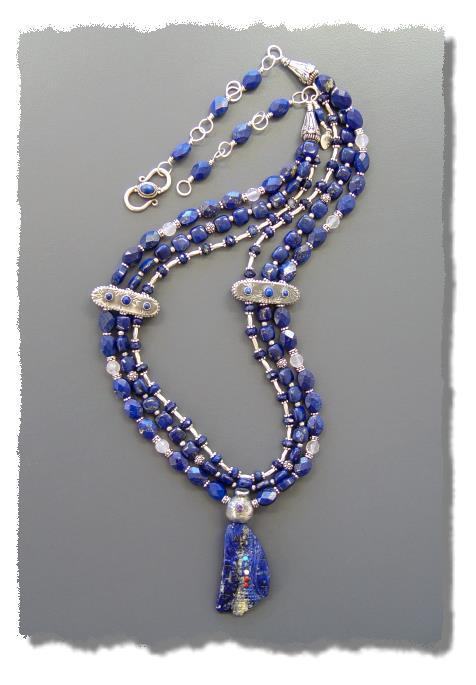This necklace was a special order. As with all special orders, I present ideas for the customer to select from, and do my best to understand what they would like to have. I would be happy to work with YOU on a special order too! If you like, I can show you web pages I've provided to customers which allow them to select ideas they like. In this case, the customer saw this gorgeous corn maiden and wanted a necklace in her favorite color (blue). The maiden is carved on both sides, the reverse has an inlaid Zuni sun so the necklace had to be reversible. The maiden had a bail attached so she could be worn on a chain, but I'm never happy with a pendant hanging on a chain in the first place, and was even less happy with a wire coming out of the beautiful figure's head. Yet I didn't want to hide the wind-blown edge of her skirt under a bezel either. What to do?! I decided to make a teensy silver olla (a water pot sometimes used to store fetishes) which she could carry on her head and which would disguise the bail. It was made by coiling PMC and building it up just as old clay pots were made. For some reason that crazy idea made sense to me at the time. I hope it wound up looking like an old coiled pot.
It is curious that the colors of the dots on the side shown here reflect the colors of the first five chakras, although chakra lore is not traditional to the Zuni. Still, if chakra lore is accurate, everyone should detect the same colors no matter what tradition they come from. Because of these dots, the customer wanted to continue the theme by having a tiny amethyst set in the olla. The reverse also has dots but not in the chakra sequence, so she asked for a tiny citrine on the other side of the pot.
The next challenge was her request to incorporate rose quartz in the necklace. She discovered that lapis can bring up "psychic debris" and the impact should be softened with the rose quartz. The very thought of trying to combine those two stones made me fret. How do you bring a wind element, opaque, primary color stone like lapis together with a misty, water element, translucent pastel one like rose quartz? I would never have tried it if she hadn't asked, and was amazed to discover that lapis and rose quartz love one another!
Let's look at this lovely corn maiden. It is clear that Stuart Quandalacy recognized something special in the stone: notice how he made the lighter/yellowish areas of the stone (most likely white calcite) represent the corn kernels. There are many stories about corn maidens. The stories are reasonably consistent in various traditions insofar as something happens which causes the corn maidens to leave and the crop fails. The maidens have to be found and asked to return to save the people from starvation. Thus far, they have been willing to return.
Generally there are six to eight maidens. The original six correspond to the colors of the six directions, there is an additional one for sweet corn and one for squash. If our maiden is intended to represent the blue corn maiden, she would be the maiden of the west, associated in some traditions with introspection. Lapis is an excellent choice of stone, Simmons says of it, "Lapis is a steadfast aid in the deep inner journey."
Considering corn itself for a moment, it appears it was imported from Mexico and had become a staple of North American Indian tribes by 1000 B.C.E. Corn, unlike most crop plants, does not re-seed itself. It required a nurturing relationship including replanting every year, and it rewarded its stewards with food, pollen and husks uses for many purposes. This mutual nurturing relationship is a far cry from today's agribusiness. I hope readers have educated themselves about the disastrous dependence the big chemical and agribusiness companies want to create on GMO corn and other foods. If not, the Wikipedia article on transgenic corn is a place to start, though it barely scratches the surface. It is notable that at the time of writing, the EU has banned virtually all GMO foods whereas the United States does not even have a labeling requirement for them (we know which lobbying interests have produced this despicable situation). One other very interesting difference is that in the EU, the government bears health insurance costs whereas of course here that is not the case. So the EU governments' concern about GMO foods may have an economic aspect. The alternative health doctors, blogs, etc. as well as environmental organizations are pretty much uniformly opposed to GMO in any form, making it all the more outrageous that labeling is not required. I know there is a great deal of hate directed toward "enviro-nazis," but just stop for a second and consider 1) how little we know about playing God by combining genes from vastly different species into our food; and 2) the rather obvious fact that the chemical/agribusiness companies are interested in profit, not in our health. The emergence of bizarre and horrific diseases has already begun (consider Morgollon's). Wouldn't it be wise to be cautious? I wonder if the corn maidens will abandon factory farms altogether. I hope it happens before all the bees and bats have gone extinct.



